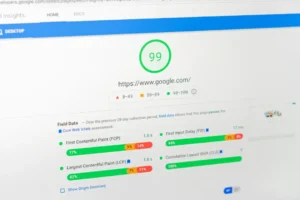
SEO Optimization: Introduction to SEO in 2024
Search Engine Optimization (SEO) has become a cornerstone of digital marketing, playing a critical role in enhancing online visibility and driving business growth. As businesses continue to recognize the importance of maintaining an effective online presence, understanding SEO’s evolution and current trends is essential for any successful strategy. In 2024, SEO is expected to undergo significant transformations, adapting to an increasingly competitive digital landscape.
Historically, SEO focused primarily on keyword placement and backlink building, which, while still relevant, no longer encompass the full spectrum of optimization. Over the years, search engines have evolved, particularly with advancements in algorithms and user intent recognition. The introduction of artificial intelligence and machine learning has fundamentally changed how search engines interpret and rank content. Consequently, effective SEO strategies must go beyond traditional tactics to include a multifaceted approach that considers user experience, content quality, and engagement metrics.
In 2024, businesses must prioritize a comprehensive understanding of their target audience along with the latest SEO strategies. This necessitates an in-depth analysis of search patterns, preferences, and behaviors to ensure that content effectively meets user expectations. Furthermore, with the growing emphasis on mobile optimization and voice search, the need for a mobile-first approach has never been clearer. Optimizing for diverse devices and platforms ensures that businesses can reach their audience effectively, regardless of how users access content.
This increased complexity in the digital landscape calls for companies to stay informed about the latest trends and tools available for enhancing their SEO strategies. By doing so, they will be better equipped to maintain visibility in search engine results and to adapt to future changes. As we delve deeper into the latest SEO strategies for 2024, a thorough understanding of its foundational principles will serve as an essential guide for achieving online success.
Understanding Keyword Research for 2024
As we enter 2024, keyword research continues to be a pivotal element of search engine optimization (SEO). The landscape of keyword analysis has evolved significantly, reflecting changes in how users interact with search engines. New tools and techniques are now available, allowing SEO professionals to identify and analyze keywords more effectively, which is crucial for staying ahead in the competitive digital environment.
Long-tail keywords are increasingly vital in 2024’s keyword strategies. These specific phrases generally consist of three or more words and cater to particular search intents. Targeting long-tail keywords can enhance visibility in niche markets and attract highly relevant traffic. By focusing on these terms, businesses can align their content more efficiently with user needs, thereby improving engagement and conversion rates.
In addition to understanding the importance of long-tail keywords, it’s essential to recognize the shift towards semantic search. This trend emphasizes the meaning behind search queries rather than mere keyword matching. As artificial intelligence and machine learning technologies improve, search engines are better equipped to interpret user intent. Therefore, keyword strategies must be developed with context in mind, considering factors like location and the user’s previous interactions with search results. This requires SEO practitioners to adopt a more holistic approach to keyword research.
Understanding user queries is paramount for effective keyword selection. Analyzing search intent involves identifying whether the user is looking for information, trying to make a purchase, or seeking a specific website. By discerning these intentions, keyword research can be tailored to fulfill audience needs, resulting in more relevant content and improved search engine rankings. In conclusion, mastering keyword research in 2024 entails embracing long-tail keywords, prioritizing semantic search, and comprehending search intent, thus unlocking the path to successful SEO strategies.
Content Optimization Techniques
In the ever-evolving landscape of search engine optimization (SEO), the significance of content optimization cannot be overstated. High-quality, engaging content serves as the cornerstone of any effective SEO strategy, especially in 2024. It is essential to create content that not only resonates with the target audience but also aligns with search engine algorithms. This involves a multi-faceted approach that includes on-page elements, such as headings, meta descriptions, images, and internal linking.
Utilizing proper headings (H1, H2, H3, etc.) helps in structuring the content, making it easier for users and search engines to navigate. Furthermore, meta descriptions play a crucial role in enticing users to click on links in search results. Crafting compelling, keyword-rich meta descriptions ensures that content is not only optimized for search engines but also appealing to prospective readers. It becomes imperative to engage users right from the search engine results page.
Images are also vital for effective content optimization. They not only enhance the visual appeal but serve as an important SEO element, especially when optimized with relevant alt text and descriptive filenames. This provides search engines with context about the image content, improving overall visibility.
Internal linking is another strategy that cannot be overlooked. By interlinking related content within your site, you not only help with website navigation but also distribute page authority across different sections. This practice enhances user engagement and can lead to increased dwell time, a factor that search engines consider when ranking pages.
Furthermore, the integration of structured data into your content provides search engines with additional information about the content’s context. Implementing rich snippets can enhance visibility in search results, driving higher click-through rates. As we move forward into 2024, employing these content optimization techniques can significantly contribute to unlocking success in your SEO efforts.
The Importance of Quality Backlink Building
Backlink building remains a cornerstone of effective SEO strategies as we look towards 2024. The links that direct users from other websites to your own are not merely an indication of popularity, but they are pivotal in enhancing search engine rankings. However, it is essential to distinguish between quantity and quality when it comes to backlinks. High-quality backlinks come from reputable, authoritative sources that are relevant to your industry, imparting credibility to your own site. On the other hand, accumulating numerous low-quality backlinks can have a detrimental effect, leading to penalties from search engines.
One effective strategy for acquiring high-quality backlinks is through guest blogging. This approach allows you to write and publish content on another site, providing value to their audience while embedding links back to your own site. When targeting platforms for guest posts, choose those that align closely with your niche, ensuring that the audience you reach is both relevant and engaged. This not only helps in building backlinks but also boosts your visibility among potential customers.
Influencer collaborations serve as another viable avenue for backlink building. By partnering with industry influencers—individuals with substantial followings and authority in your field—you can create content that resonates with their audience while earning quality backlinks. This strategy can significantly enhance your site’s authority and reach, given that backlinks from respected influencers carry weight in the eyes of search engines.
Furthermore, leveraging social media channels can complement your backlink strategy. Sharing your original content through these platforms can encourage others to link back to your site, particularly if the content resonates with users and encourages engagement. By implementing these practices—guest blogging, influencer partnerships, and utilizing social media—you foster a backlinks profile that enhances your overall SEO performance, ultimately driving traffic and improving your site’s ranking in search results.
Technical SEO Enhancements
Technical SEO refers to the process of optimizing a website’s infrastructure to facilitate crawling and indexing by search engines. Effective technical SEO is paramount in today’s digital landscape, as it can significantly impact a site’s visibility and performance in search engine results. One of the critical elements of technical SEO is site speed. A fast-loading website not only improves user experience but also serves as a ranking factor for search engines like Google. To enhance site speed, website owners should consider optimizing images, leveraging browser caching, and using content delivery networks (CDNs).
Another pivotal aspect of technical SEO is mobile-friendliness. With a growing number of users accessing the web via mobile devices, having a responsive design is essential. Ensuring your website is optimized for various screen sizes will not only help in retaining users but will also affect your rankings in mobile search results. Google’s mobile-first indexing means that Google predominantly uses the mobile version of the site for indexing and ranking, which further emphasizes the importance of mobile optimization.
Indexability is equally critical in technical SEO. A well-structured website ensures that search engine crawlers can easily navigate and index the content. This includes proper use of HTML tags, the creation of an XML sitemap, and the implementation of a robots.txt file to guide search engine crawlers on which pages to access or ignore. It is also advisable to regularly check for crawl errors and rectify them to maintain a healthy index status.
Incorporating best practices such as using secure HTTPS connections, optimizing URL structures, and improving the overall site architecture can further enhance technical SEO. By addressing these aspects, website owners can create a more efficient environment for search engines, ultimately leading to improved site performance and higher organic rankings in search results.
User Experience (UX) and SEO
User experience (UX) has emerged as a critical element influencing SEO rankings, especially in 2024. As search engines evolve towards prioritizing human-centric designs, the correlation between UX and SEO grows stronger. A well-designed website not only attracts visitors but also encourages them to stay longer, interact, and ultimately converts them into customers. The intricacies of website design, including layout, color schemes, and image placement, play a significant role in retaining users. Clean, intuitive designs that promote seamless navigation enhance user satisfaction and directly impact SEO performance.
Navigation is another fundamental component of UX that must not be overlooked. A website should enable users to find information effortlessly, with logical categorization and clear pathways to desired content. Confusing navigation can frustrate users, increasing the bounce rate and negatively affecting SEO rankings. For optimal SEO benefits, it is essential to align the navigation structure with user expectations, incorporating relevant keywords and phrases that resonate with the target audience.
In today’s digital landscape, mobile responsiveness is imperative. With an increasing number of users accessing websites via mobile devices, search engines have adapted their algorithms to favor mobile-friendly sites. Websites that are not optimized for mobile can result in poor UX, leading to lower click-through rates and shorter dwell times. Both of these metrics are vital for SEO, as they indicate to search engines that the content may not be delivering a satisfactory experience. Therefore, ensuring a fast, responsive web design across all devices is paramount in maintaining high SEO rankings.
Overall, the relationship between user experience and SEO is intricate and essential in 2024. By focusing on website design, navigation, and mobile optimization, site owners can significantly enhance user engagement and satisfaction, which are critical components for achieving higher visibility on search engine results pages.
Leveraging Local SEO Strategies
In 2024, local SEO has emerged as a critical element for businesses aiming to enhance their online presence within specific geographic areas. As consumers increasingly rely on search engines to find local services and products, optimizing for local SEO is no longer optional; it’s essential. By implementing effective local SEO strategies, businesses can significantly improve their visibility in local search results, drive foot traffic to their physical locations, and attract potential customers actively looking for their offerings.
One of the primary local SEO strategies is optimizing a Google My Business (GMB) listing. A well-optimized GMB profile provides essential information such as a business’s name, address, phone number, and operating hours. Additionally, including relevant business categories and services, along with high-quality images, can significantly enhance the attractiveness of the listing. Businesses should ensure that their GMB information is accurate and up-to-date, as this can directly influence customer engagement and the likelihood of achieving higher rankings in local search results.
Another effective tactic for boosting local SEO is acquiring local citations. These are mentions of a business’s name, address, and phone number across various online platforms, including directories and local websites. By ensuring consistent and accurate citations, businesses can build credibility and trustworthiness, essential factors in local search algorithms. It is advisable to prioritize locally relevant directories and platforms that resonate with the target audience.
Encouraging customer reviews also plays a pivotal role in local SEO strategies. Positive reviews not only enhance a business’s reputation but also signal to search engines that the business is reputable, thereby influencing its ranking in local search results. Prompting satisfied customers to leave reviews on popular platforms such as Google and Yelp can bolster local visibility significantly. Engaging with customers through responses to reviews can further foster community relations and establish customer loyalty.
Monitoring and Analytics for SEO Success
Effective monitoring and analytics play a crucial role in achieving success in SEO strategies. By utilizing various tracking tools and metrics, businesses can assess the performance of their optimization efforts and make informed decisions for future enhancements. One essential tool is Google Analytics, which provides valuable insights into website traffic, user behavior, and conversions. By analyzing this data, organizations can identify which keywords and content pieces are driving the most traffic, allowing them to refine their SEO strategies accordingly.
Another vital component is the Google Search Console, which offers data regarding how a website appears in search results. This tool enables users to analyze search queries, impressions, and click-through rates, helping to gauge the effectiveness of specific keywords. Additionally, Search Console notifies users about technical issues or penalties that could negatively impact SEO performance. Proactively addressing these issues not only protects a site’s ranking but also improves user experience.
Tracking keyword rankings is another essential aspect of SEO monitoring. Numerous tools are available for this purpose, such as SEMrush, Ahrefs, and Moz. These tools provide detailed information on keyword rankings over time, enabling businesses to determine the effectiveness of their SEO efforts. Furthermore, monitoring competitors’ performance can help identify new opportunities and strategies to improve search visibility.
Analytics should not only focus on quantitative metrics, such as traffic and rankings, but also qualitative factors such as user engagement and satisfaction. Metrics like bounce rate, dwell time, and page views per visit can indicate how effectively content resonates with visitors. By closely monitoring these aspects, businesses can gain a comprehensive understanding of their SEO performance and make data-driven decisions to enhance their online presence.
Conclusion: Staying Ahead in the SEO Game
In the ever-evolving landscape of digital marketing, staying ahead requires a deep understanding of the latest SEO optimization strategies. The key points discussed throughout this blog post emphasize the necessity of adapting to frequent changes in search engine algorithms and user behavior. Innovative practices, such as focusing on user experience, optimizing for voice search, and implementing robust local SEO strategies, are essential for enhancing online visibility. Additionally, embracing the power of AI-driven tools can dramatically improve content quality and relevance.
As we move into 2024, it is crucial for website owners and marketers alike to remain vigilant and proactive in their approach to search engine optimization. Keeping abreast of the latest trends and algorithm updates ensures that your website does not fall behind the competition. Regularly analyzing your SEO performance through tools and metrics will provide insights necessary for making informed decisions and refining strategies.
It is equally important to remember that SEO is not a one-time effort but a continuous process. Implementing the strategies outlined can significantly improve search engine rankings, but consistent monitoring and adjustment are vital for long-term success. By investing time and resources into staying updated with SEO practices, you empower your online presence, driving organic traffic and increasing the chances of achieving your business objectives. Therefore, take a strategic approach, embrace the recommended tactics, and watch your website thrive in the digital space.








